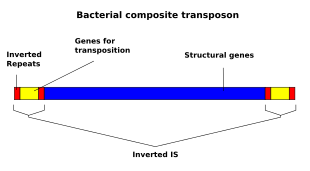
Back جين قافز Arabic Транспозон Bulgarian Transpozon BS Transposó Catalan Transpozon Czech Transposon Danish Transposon German Transposón Spanish Transponeeruvad elemendid Estonian Transposoi Basque

A transposable element (TE), also transposon, or jumping gene, is a type of mobile genetic element, a nucleic acid sequence in DNA that can change its position within a genome, sometimes creating or reversing mutations and altering the cell's genetic identity and genome size.[1][2]
Transposition often results in duplication of the same genetic material. The discovery of mobile genetic elements earned Barbara McClintock a Nobel Prize in 1983.[3] Further research into transposons has potential for use in gene therapy, and the finding of new drug targets in personalized medicine. The vast number of variables in the transposon makes data analytics difficult but combined with other sequencing technologies significant advances may be made in the understanding and treatment of disease.[4]
Transposable elements make up about half of the genome in a eukaryotic cell, accounting for much of human genetic diversity.[4] Although TEs are selfish genetic elements, many are important in genome function and evolution.[5] Transposons are also very useful to researchers as a means to alter DNA inside a living organism.
There are at least two classes of TEs: Class I TEs or retrotransposons generally function via reverse transcription, while Class II TEs or DNA transposons encode the protein transposase, which they require for insertion and excision, and some of these TEs also encode other proteins.[6]
- ^ Bourque G, Burns KH, Gehring M, Gorbunova V, Seluanov A, Hammell M, et al. (November 2018). "Ten things you should know about transposable elements". Genome Biology. 19 (1): 199. doi:10.1186/s13059-018-1577-z. PMC 6240941. PMID 30454069.
- ^ Makałowski W, Gotea V, Pande A, Makałowska I (2019). "Transposable Elements: Classification, Identification, and Their Use as a Tool for Comparative Genomics". In Anisimova M (ed.). Evolutionary Genomics. Methods in Molecular Biology. Vol. 1910. New York, NY: Humana. pp. 185–186. doi:10.1007/978-1-4939-9074-0_6. ISBN 978-1-4939-9074-0. PMID 31278665. S2CID 195814061.
- ^ McClintock B (June 1950). "The origin and behavior of mutable loci in maize". Proceedings of the National Academy of Sciences of the United States of America. 36 (6): 344–55. Bibcode:1950PNAS...36..344M. doi:10.1073/pnas.36.6.344. PMC 1063197. PMID 15430309.
- ^ a b Wellinger, RE, et al. (2022). "A new challenge for data analytics: transposons". BioData Mining. 15 (9): 9. doi:10.1186/s13040-022-00294-x. PMC 8957154. PMID 35337342.
- ^ Bucher E, Reinders J, Mirouze M (November 2012). "Epigenetic control of transposon transcription and mobility in Arabidopsis". Current Opinion in Plant Biology. 15 (5): 503–10. Bibcode:2012COPB...15..503B. doi:10.1016/j.pbi.2012.08.006. PMID 22940592.
- ^ Pray LA (2008). "Transposons: The jumping genes". Nature Education. 1 (1): 204.